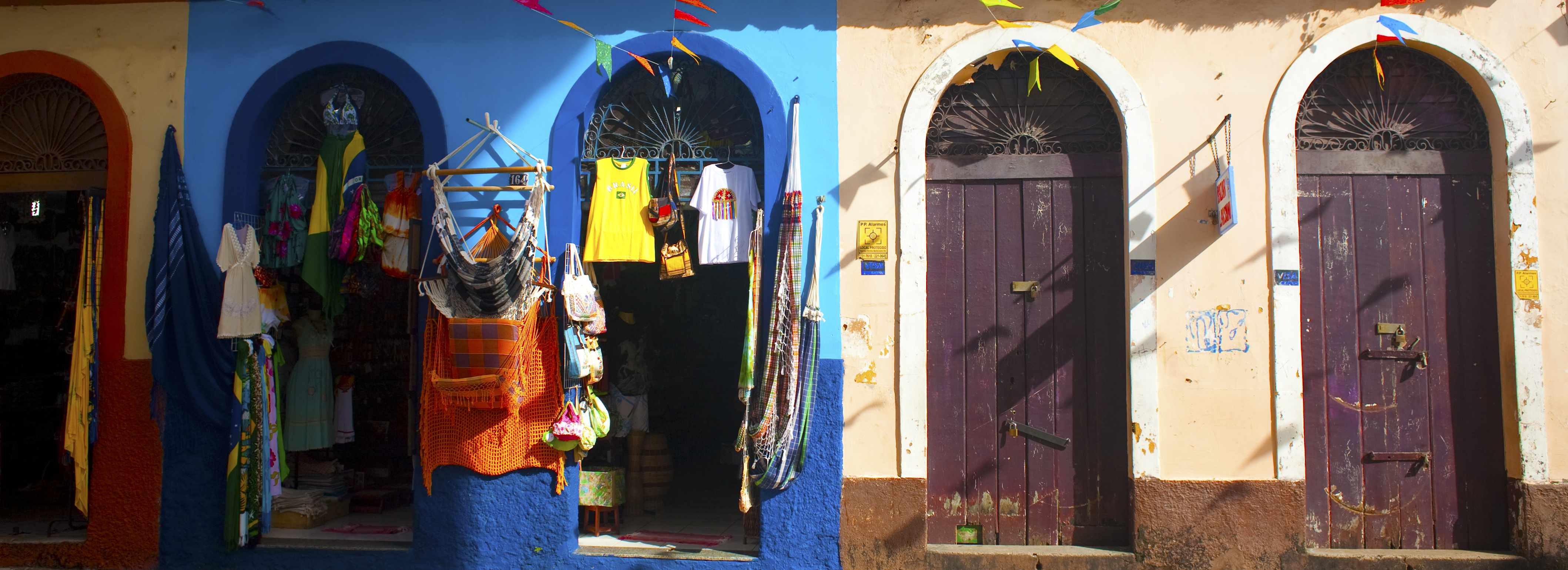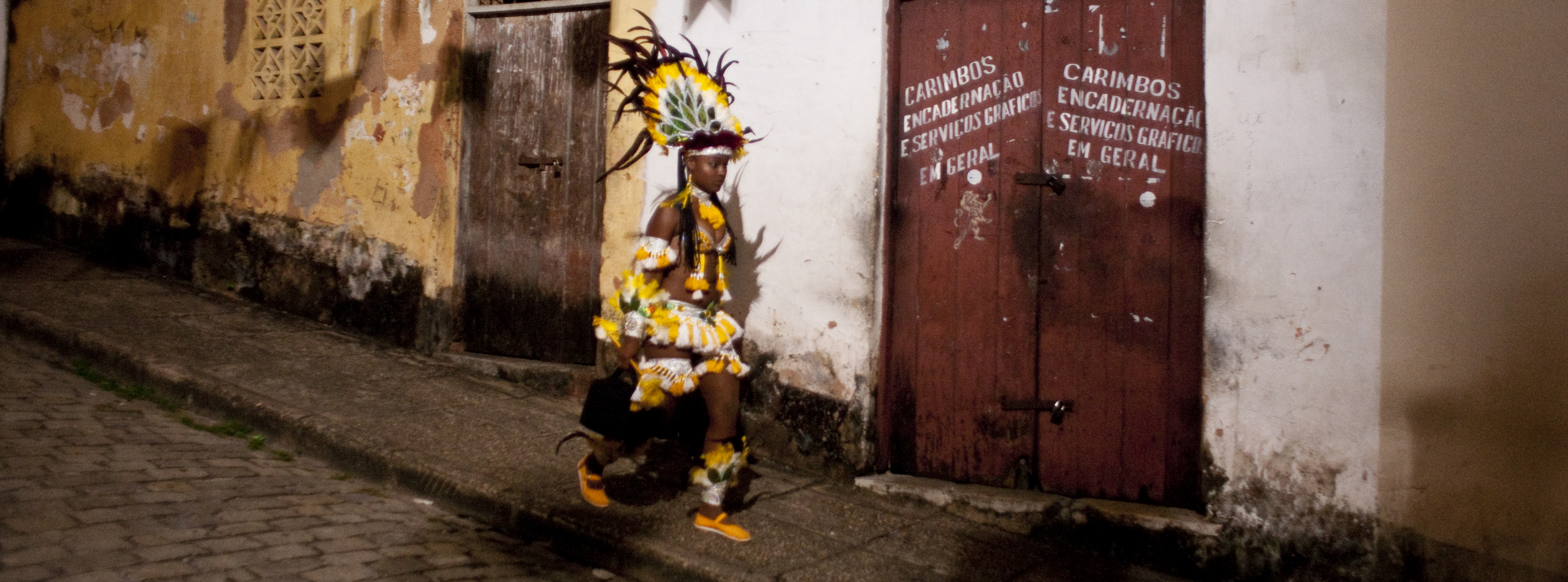
Home Yoga Brazil Research Photography Biography Contact Site Map
Meredith W. Watts
Yoga - Research - Photography
Research on Brazilian Cultura Popular

Meredith Watts and Simone Ferro have a long-term research project on popular culture/cultura popular in the Northeast of Brazil. A major focus is on the Bumba-meu-boi festival in Sao Luis, Brazil in the federal state of Maranhao. The project has now produced thousands of photographs, dozens of videos, several academic publications and conference papers, and a number of choreographic works. Undergraduate students in dance have participated in a Study Abroad course offered every two years, and student researchers have developed their own dance pieces and research work based on the experience.
The project includes what is broadly called cultura popular in Brazil, a term that two primary meanings.
The first meaning is that of "culture of the people," usually connoting practices that are older, more "traditional," and associated with the less privileged segments of the population. Historically this term overlaps with, but often replaces, the term folklore. The designation "folklore" stems from 19th century efforts, beginning in England, to recover and preserve traditional popular practices, lore and music. The term still carries a sense of historical preservation and ancient practice.
The second meaning of cultura popular is similar to that of "popular culture" in contemporary American and Eurpean usage; namely, the modern transmission of news and entertainment through mass media. This process is normally associated, particularly in Latin America, with the expansion of radio in the 1930s and television in the 1960s. However, there were much earlier examples (at least in Europe) in the proliferation of pulp fiction and popular literature that followed the expansion of literacy, and more recent influences in the impact of electronic social and informational media through the internet and social media.
In contemporary usage, cultura popular refers to older practices, but also includes the continual process of innovation and negotiation in th creation of popular culture. It is not the museumized practice of folkloric creation, but a dynamic process of creating identity, artistic expression, and even commercial enterprpise. Cultura popular is still associated with more traditional, rural environments, but it is also a vital force in urban neighborhoods. The Bumba-meu-boi is such an example, being practiced in modest rural settlements under very simple conditions and in small towns in the interior, but also in the capital city of São Luis with the incorporation of contemporary production values.
An even more elaborate production, reminiscent of the Carnival, is practiced annually in the Amazonian city of Parintins. Our own research has concentrated on the "Boi" as practiced in Maranhão, where hundreds of festival groups display enormous diversity and ingenuity in negotiating the space between traditional and entertainment culture.
In practice the two meanings of cultura popular are often difficult to separate. Culture of "the people" is dynamic and may incorporate images, symbols and techniques associated with mass entertainment and media. Traditional celebrations with origins centuries in the past may lose or transform their original symbolic grounding and include symbols and stories from contemporary media; although the term is a bit awkward, we often refer to this process as "detemporalization," the process of mixing older and newer content in traditional celebrations. In this case, both meanings of cultura popular merge and older forms of dance and celebration take on modern entertainment values. Much of our research on the Bumba-meu-boi festival focuses on this interplay between tradition and modernity, between preservation and innovation.
The Bumba-meu-boi Festival of
São Luis (Maranhão), Brazil

For several years Meredith Watts and Simone Ferro (Department of Dance, Peck School of the Arts, University of Wisconsin-Milwaukee) have been carrying out research in northeast Brazil, particularly on African-Brazilian influences and on the popular festival known as Bumba-meu-boi.
This work has been supported by many different organizations, including the Peck School of the Arts, the Center for Latin American and Caribbean Studies (CLACS), the Department of Dance, and the Graduate School (all of the University of Wisconsin-Milwaukee).
Videos of the groups in performance, and more about Simone's choreographic work can be found on http://www.simoneferro.com.
The celebration of the Bumba-meu-boi festival (folguedo) has its peak during the period of June 23-30 each year, but preparations take place for at least half the year. The traditional cycle begins with rehearsals around Easter and continue until fall; some groups have extended their performance schedule and are more or less continuously active. These portraits show some of the leaders, singers, and performers who keep the tradition alive throughout the year.
The boi itself is an elaborately decorated symbolic ox of three to five feet in length that is the center of the celebration. For groups that can afford it, the boi is renewed with an elaborately embroidered "skin" each year; by custom, the new ox is given a symbolic baptism on the eve of St. John, the patron saint of the festival. Examples can be seen in the albums of Bumba-meu-boi groups in the Photo Gallery. The photo sets represent the major sotaques, or rhythmic styles, of the Bumba-meu-boi as it is practiced in São Luis, Maranhão, in northest Brazil. The gallery includes sotaques popularly known as Matraca (or Ilha), Baixada (or Pindare), Orquestra, Zabumba, and Costa da Mão.
These albums number 30-40 photos each and are meant to introduce the groups and the sotaques to students and others interested in the festival as practiced in São Luis. (Please note that the display and transitions of the photos may be slow in some browsers.)
The albums are also for the groups themselves as a way of sharing our images of them and expressing our thanks for their generosity and support during our yearly visits to São Luis. Albums of more groups and will be added continually. Also, a repository of short videos of groups in performance are available on http://simoneferro.com.
RESEARCH PAPERS
There are currently a number of research papers discussing the Bumba-meu-boi. Most have been presented at conferences and are being prepared for publication.
One paper is currently scheduled for publication in the Journal of Popular Culture under the title "The Coexistence of Folk and Popular Culture as Vehicles of Social and Historical Activism: Transformation of the Bumba-meu-Boi in Northeast Brazil."
For more on this research, see http://www.simoneferro.com. That site contains copies of current research papers, a photo gallery, and a growing repository of short videos of Bumba-meu-boi groups filmed in performance during the June festival in São Luis.
© 2012 meredithwwatts.com| Contact | Terms of Service
